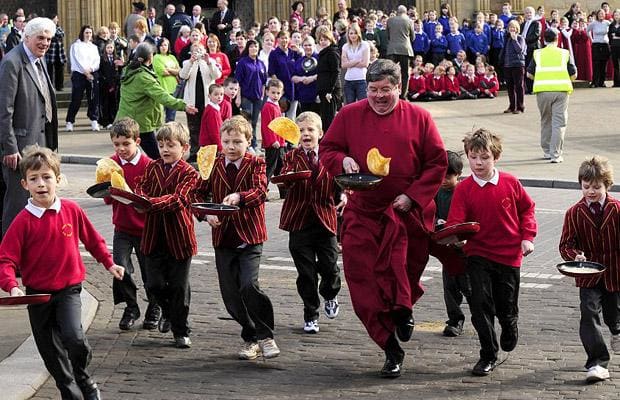Why is there a tradition of eating pancakes on Shrove Tuesday? How did Ash Wednesday and Shrove Tuesday get their peculiar names? And why is this time of year associated with early versions of football, cock fighting and the strange figure of Jack-a-Lent?
Ash Wednesday, which this year falls on March 1st, is the first day of Lent – a forty-day fast in the run-up to Easter. In the past, Christians would mark this period by avoiding meat, cheese, cooking fat and eggs, and trying to behave in a sombre and serious fashion.
This had the inevitable effect of encouraging people to get their fill of rich fatty foods and to indulge in boisterous behaviour before this downbeat time started.
This is why the tradition of wolfing down pancakes – made of butter, eggs and lard – on Shrove Tuesday (the day before Ash Wednesday) arose. As well as enabling people to enjoy these foodstuffs before the long weeks of frugal meals began, pancake-making was a chance to use up any such ingredients.
A number of customs are associated with Shrove Tuesday pancakes. Britain’s oldest pancake race takes place in Olney, Buckinghamshire, with the competitors – dressed as traditional housewives – flipping their pancakes as they run.


In Bedfordshire, there used to be a custom of children running to a certain hill and putting their ears next to the earth to “hear the old lady frying her pancakes underground.”
Nowadays only Catholics and very devout Anglicans seem to observe Lent, and their fasting often involves giving up just one indulgence, like chocolate or alcohol. But though the practice of strict fasting at Lent has gradually decreased, pancake eating on Shrove Tuesday has survived.
About 52 million eggs are consumed in the UK on Shrove Tuesday, which is 22 million more than normal.


Shrove Tuesday was traditionally a time of disorder. It was a day for cock fighting and cock throwing (hurling objects at birds tethered to the ground). It was also a time when many ‘football matches’ were held.
Past versions of football were different to the game we know today. The ball could be carried or thrown as well as kicked, the teams could have scores of members, and there were few rules – often the games resembled little more than all-out brawls. The goals might be several miles apart and the game could take most of the day.
Many of these Shrove Tuesday football matches were banned due to their roughness, but a few have survived, in slightly cleaned-up forms. One such game takes place in Sedgefield, County Durham.
This game is played with a cricket-sized ball, which is passed through a metal bull-ring on the village green at the start and finish of the match. Though the action in Sedgefield is still fairly robust, play stops sometimes to let a pensioner or child have a ‘lucky kick’ at the ball.
There was also a ‘trick-and-treating’ type custom practised on Shrove Tuesday in certain parts of the country as well as some mischief-night-style shenanigans, during which the houses of unpopular people could be vandalised.
There seems to have been a belief that at certain ‘turning points’ of the year, like Halloween (the beginning of the colder, darker part of the year), Christmas (the winter solstice) and Shrove Tuesday (the start of spring) normal rules were suspended and more disorder than usual was allowed.
Ash Wednesday was a calmer day than its predecessor. The name of this day comes from a pre-Reformation practice in which priests blessed ashes, sprinkled them with holy water then daubed this mixture on the foreheads of kneeling members of the congregation while saying, “Remember man thou art dust and to dust thou shall return.”


Though this practice was abolished in England in 1548, the name Ash Wednesday has lived on. (The name Shrove Tuesday comes from ‘shriving’ – meaning that people confessed their sins to the priest and received absolution before the holy period of Lent began.)
One strange custom practised on Ash Wednesday involved a figure called ‘Jack-a-Lent’ – an effigy of wood and straw that was dressed in old clothes and paraded around the streets.
This procession was accompanied by a great deal of noise and merriment before the Jack-a-Lent was ‘killed’ by being shot, burnt, pelted with stones or torn apart. It has been suggested that this unfortunate figure represented Christ’s betrayer Judas Iscariot.
Other researchers argue it represented the merriment of Shrove Tuesday being put to death before the solemnness of Lent started. (There were similar customs on the Continent, where the carnival period before Lent could last several weeks and a figure representing carnival was symbolically executed on the last day of the festivity.)
The figure could also represent the winter being put to death to celebrate the onset of spring. The Jack-a-Lent tradition seems to have died out in England by the late 1800s.

























